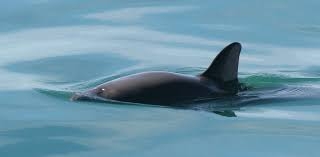
The vaquita is a species of porpoise endemic to the northern end of the Gulf of California in Baja California, Mexico. Averaging 150 cm (4.9 ft) (females) or 140 cm (4.6 ft) (males) in length, it is the smallest of all living cetaceans.
Vaquitas are generally seen alone or in pairs, often with a calf, but have been observed in small groups of up to 10 individuals.
Little is known about the life history of this species. Life expectancy is estimated at about 20 years and age of sexual maturity is somewhere between 3 and 6 years of age. While an initial analysis of stranded vaquitas estimated a two-year calving interval, recent sightings data suggest that vaquitas can reproduce annually. It is thought that vaquitas have a polygynous mating system in which males compete for females. This competition is evidenced by the presence of sexual dimorphism (females are larger than males), small group sizes, and large testes (accounting for nearly 3% of body mass).
This species inhabits shallow, murky lagoons along the shoreline where there is strong tidal mixing, convection processes and high food availability. Individuals are generally seen traveling alone or in small groups of 1-3 individuals, although they are sometimes observed swimming in groups as large as ten. They feed primarily on bony fish and squid which are found at or near the bottom of the sea.
Picture Credit : Google




